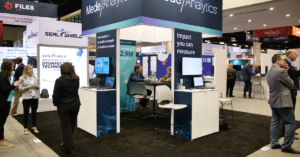We recently sat down with Tyler Downs, CTO of MedeAnalytics to discuss trends in machine learning in healthcare. He offered insights into how MedeAnalytics is using machine learning to power data analytics and what’s in store for the future of the technology.
Q: What exactly is machine learning?
A: In layman’s terms, machine learning is the application of artificial intelligence that enables computers to automatically learn and improve from experience without being explicitly programmed. It’s all about developing computer programs that can access data and learn from it themselves.
Machine learning is used every day in social networking, commuting apps, and online shopping. Think of Facebook. When you upload photos to Facebook, it automatically highlights faces and suggests friends to tag. Facebook also uses algorithms to personalize your newsfeed and ensure you’re seeing posts that interest you. Google Maps analyzes the speed of traffic at any given time. And on Amazon, you see recommendations for products you might be interested in, displaying “customers who bought this item also bought…”. These all use forms of machine learning.
Q: How is machine learning being used in healthcare?
A: Think about the huge volumes of data being generated in healthcare. Machine learning can be trained to look at structured and unstructured data (images, video, audio files), identify anomalies, and point to areas that need attention.
There are clinical, financial, and operational applications of machine learning in healthcare. In the clinical realm, Google has developed a machine learning algorithm to aid in tumor-detection on mammograms. Stanford is using algorithms to identify skin cancer.
In the revenue cycle, machine learning can be used to predict denials, improve point-of-service collections, and identify a patient’s propensity to pay their bills. This enables the health system to increase reimbursement, reduce the cost collect, reduce bad debt, and more.
For healthcare operations, machine learning enables providers to improve throughput in the OR and ED, assess the risk of no-shows, identify trends in patient volumes, determine the appropriate appointment length, and enable schedulers to allocate the right amount of time for procedures based on the individual patient and physician. These capabilities drive down costs, which is important considering the average cost of an OR can be as much as $60-80 per minute (Stanford).
Q: How is MedeAnalytics using machine learning?
A: A key component of machine learning is data discovery, data mapping, and statistical analysis. We do this today. It enables us to quickly and clearly see what data is needed for a given implementation.
Our platform also uses linear regression models to learn trends based on our clients’ trends. For example, one of our payer clients might always see new member enrollment spike at the end of the month. The system learns that such spikes aren’t anomalies but are expected patterns according to historical data.
And as I mentioned before, we can help providers predict a patient’s propensity to pay their bill. This is crucial as deductibles and cost-sharing are on the rise. Rather than having collections agents call patients in alphabetical order, they can start with those who are most likely to pay. This brings more money into the hospital and makes collections agents more efficient, reducing the cost to collect.
We have an active data science team with PhD-level data scientists who help us uncover the possibilities with machine learning for our clients’ specific use cases.
Q: What’s in store for the future of machine learning?
The healthcare industry has only scratched the surface of what’s possible with machine learning. Machine learning in healthcare will continue to improve, resulting in better clinical outcomes, more streamlined operations, and a reduced cost of care. And as machine learning becomes more deeply ingrained in our work (and in our daily lives), it has the potential to become the infrastructure that will power a second digital revolution.
To learn more about machine learning, please contact Mike Doeff at Michael.Doeff@medeanalytics.com or ask your account manager.
Get our take on industry trends
Optimizing opportunity in value-based care
Our own Dave Schweppe (Chief Analytics Officer) and David Wolf (AVP, Payer Solutions) sat down with Todd Sauers, Manager of…
Read on...Expert Q&A: The HEDIS details all health plans need to know
With HEDIS certification season quickly approaching, we sat down with MedeAnalytics experts Melissa Linder, Director of Product Management, and Lori…
Read on...Looking back at HIMSS22
Our MedeAnalytics team was thrilled to be back in person for this year’s HIMSS event, after a two-year hiatus due…
Read on...A look ahead at payer analytics innovation
Pioneering payers know that building a strong foundation is the key to enacting sustainable innovation. This foundation typically includes the…
Read on...


